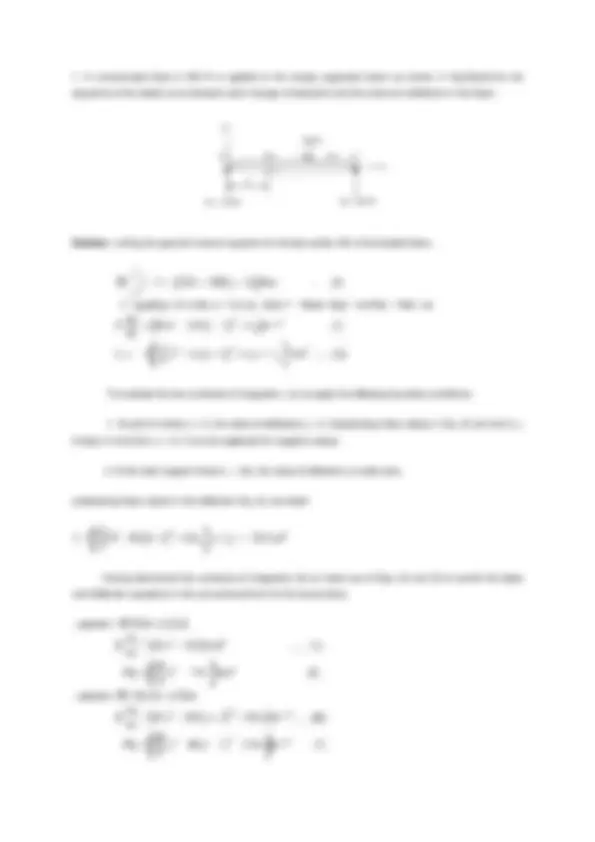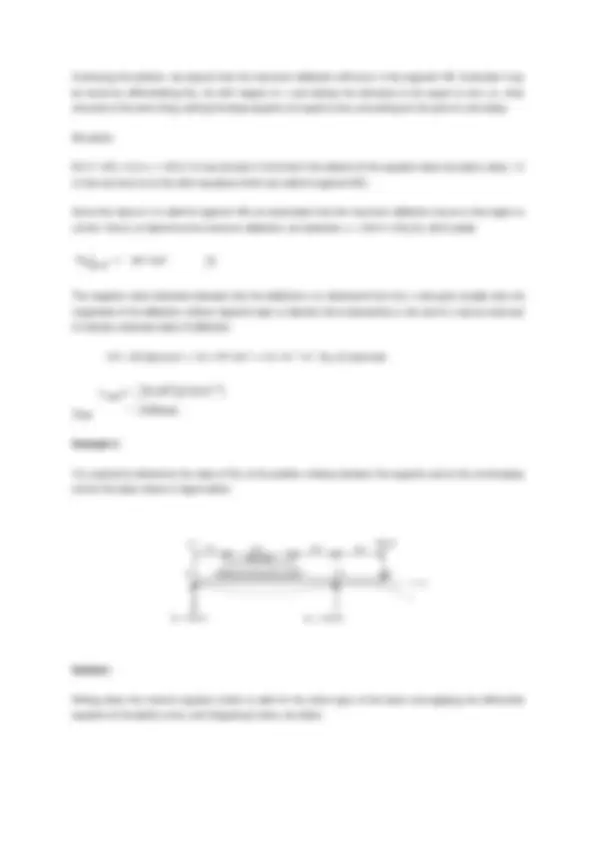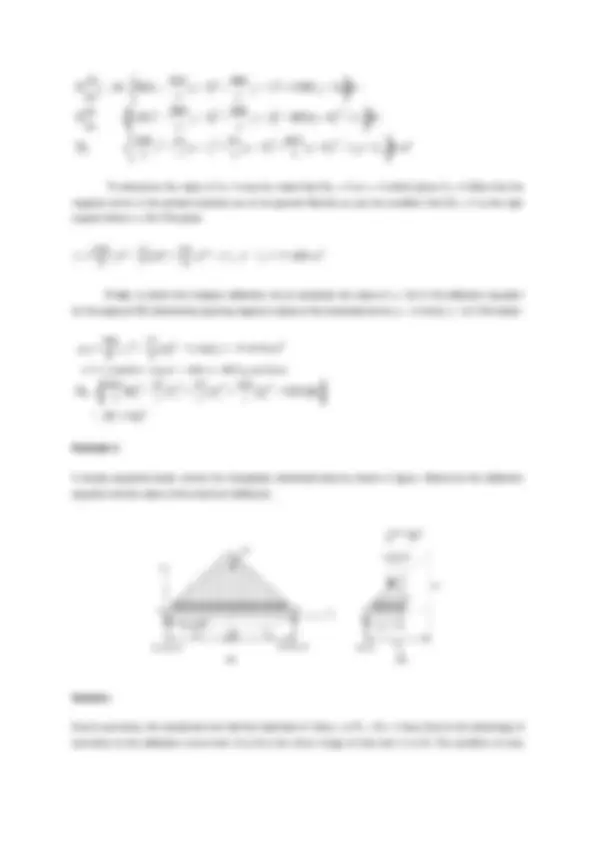






Study with the several resources on Docsity

Earn points by helping other students or get them with a premium plan


Prepare for your exams
Study with the several resources on Docsity

Earn points to download
Earn points by helping other students or get them with a premium plan
Community
Ask the community for help and clear up your study doubts
Discover the best universities in your country according to Docsity users
Free resources
Download our free guides on studying techniques, anxiety management strategies, and thesis advice from Docsity tutors
Macaulay's Method is an engineering technique used to write a single moment equation for a beam with discontinuous loading conditions. This method involves the use of pointed brackets to indicate nonexistent terms for negative values of x. examples of how to apply this method to various beam problems, including those with concentrated loads, distributed loads, and couples.
What you will learn
Typology: Lecture notes
1 / 8

This page cannot be seen from the preview
Don't miss anything!





If the loading conditions change along the span of beam, there is corresponding change in moment equation. This requires that a separate moment equation be written between each change of load point and that two integration be made for each such moment equation. Evaluation of the constants introduced by each integration can become very involved. Fortunately, these complications can be avoided by writing single moment equation in such a way that it becomes continuous for entire length of the beam in spite of the discontinuity of loading. Note : In Macaulay's method some author's take the help of unit function approximation (i.e. Laplace transform) in order to illustrate this method, however both are essentially the same. For example consider the beam shown in fig below: Let us write the general moment equation using the definition M = ( ∑ M )L, Which means that we consider the effects of loads lying on the left of an exploratory section. The moment equations for the portions AB,BC and CD are written as follows It may be observed that the equation for MCD will also be valid for both MAB and MBC provided that the terms ( x - 2 ) and ( x - 3 )^2 are neglected for values of x less than 2 m and 3 m, respectively. In other words, the terms ( x - 2 ) and ( x - 3 )^2 are nonexistent for values of x for which the terms in parentheses are negative.
As an clear indication of these restrictions,one may use a nomenclature in which the usual form of parentheses is replaced by pointed brackets, namely, ‹ ›. With this change in nomenclature, we obtain a single moment equation Which is valid for the entire beam if we postulate that the terms between the pointed brackets do not exists for negative values; otherwise the term is to be treated like any ordinary expression. As an another example, consider the beam as shown in the fig below. Here the distributed load extends only over the segment BC. We can create continuity, however, by assuming that the distributed load extends beyond C and adding an equal upward-distributed load to cancel its effect beyond C, as shown in the adjacent fig below. The general moment equation, written for the last segment DE in the new nomenclature may be written as: It may be noted that in this equation effect of load 600 N won't appear since it is just at the last end of the beam so if we assume the exploratary just at section at just the point of application of 600 N than x = 0 or else we will here take the X - section beyond 600 N which is invalid. Procedure to solve the problems (i). After writing down the moment equation which is valid for all values of ‘x' i.e. containing pointed brackets, integrate the moment equation like an ordinary equation. (ii). While applying the B.C's keep in mind the necessary changes to be made regarding the pointed brackets. llustrative Examples :
Continuing the solution, we assume that the maximum deflection will occur in the segment AB. Its location may be found by differentiating Eq. (5) with respect to x and setting the derivative to be equal to zero, or, what amounts to the same thing, setting the slope equation (4) equal to zero and solving for the point of zero slope. We obtain 50 x^2 – 133 = 0 or x = 1.63 m (It may be kept in mind that if the solution of the equation does not yield a value < 2 m then we have to try the other equations which are valid for segment BC) Since this value of x is valid for segment AB, our assumption that the maximum deflection occurs in this region is correct. Hence, to determine the maximum deflection, we substitute x = 1.63 m in Eq (5), which yields The negative value obtained indicates that the deflection y is downward from the x axis.quite usually only the magnitude of the deflection, without regard to sign, is desired; this is denoted by , the use of y may be reserved to indicate a directed value of deflection. if E = 30 Gpa and I = 1.9 x 10^6 mm^4 = 1.9 x 10 -^6 m^4 , Eq. (h) becomes Then Example 2: It is required to determine the value of EIy at the position midway between the supports and at the overhanging end for the beam shown in figure below. Solution: Writing down the moment equation which is valid for the entire span of the beam and applying the differential equation of the elastic curve, and integrating it twice, we obtain
To determine the value of C 2 , It may be noted that EIy = 0 at x = 0,which gives C 2 = 0.Note that the negative terms in the pointed brackets are to be ignored Next,let us use the condition that EIy = 0 at the right support where x = 6m.This gives Finally, to obtain the midspan deflection, let us substitute the value of x = 3m in the deflection equation for the segment BC obtained by ignoring negative values of the bracketed terms x - 4 ^4 and x - 6 ^3. We obtain Example 3: A simply supported beam carries the triangularly distributed load as shown in figure. Determine the deflection equation and the value of the maximum deflection. Solution: Due to symmetry, the reactionsis one half the total load of 1/2w 0 L, or R 1 = R 2 = 1/4w 0 L.Due to the advantage of symmetry to the deflection curve from A to B is the mirror image of that from C to B. The condition of zero
because ultimately the term Mx - a ^0 Should have the moment units.Thus with integration the quantity x - a becomes either x - a ^1 or x - a ^2 Or Therefore, writing the general moment equation we get Example 5: A simply supported beam is subjected to U.d.l in combination with couple M. It is required to determine the deflection. This problem may be attemped in the some way. The general moment equation my be written as
Integrate twice to get the deflection of the loaded beam.